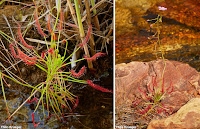 |
| Drosera maanyaa-gooljoo A.Fleischm. & T.Krueger, in Krueger, Cross, Rangers et Fleischmann, 2023. |
Abstract
Drosera maanyaa-gooljoo, a new annual species of Drosera section Arachnopus from the remote Buccaneer Archipelago and Yampi Peninsula in the northwest Kimberley region of Western Australia, is described and illustrated. Drosera maanyaa-gooljoo is a distinctive species that differs in morphology and indumentum from all previously known taxa of D. section Arachnopus. Comprehensive photo plates comparing all morphological details, as well as seed shape and structure, with those of the putatively related D. barrettiorum and D. hartmeyerorum are provided. Given D. maanyaa-gooljoo is only known from two small populations, a Priority One status under Conservation Codes for Western Australian Flora is recommended. Both populations occur within exclusive Native Title lands of the Dambimangari and Mayala Traditional Owners. This exciting new species discovery highlights the importance of both consultation with Indigenous people and herbarium revisions for alpha taxonomy and biodiversity research.
Keywords: Eudicots, carnivorous plants, Drosera barrettiorum, D. hartmeyerorum, leaf trichomes, Nepenthales, non-core Caryophyllales, sundews, taxonomy
Thilo Krueger, Adam T. Cross, Dambimangari Rangers and Andreas Fleischmann. 2023. Drosera maanyaa-gooljoo, A New Species of Drosera section Arachnopus (Droseraceae) from the Buccaneer Archipelago and Yampi Peninsula, northwest Kimberley Region, Western Australia. Phytotaxa. 618(1); 31-46. DOI: 10.11646/phytotaxa.618.1.3
It is essential for scientists who conduct research on Country to recognise the knowledge, skills, and interest in land management of Aboriginal people. We consulted with both Traditional Owner groups of the area where this species occurs over multiple years, and it was eventually decided to name this species with an Aboriginal name. Naming new species with Aboriginal words selected by the Traditional Owners themselves is rapidly becoming a common praxis in taxonomic research, especially for narrowly endemic taxa that only occur in a small area managed by a single Traditional Owner group (see, e.g., the recently described Drosera buubugujin). As in our case there are two different Traditional Owner groups speaking two different languages, a compromise for the species name had to be found. Each group selected their own name for this species and both words were then combined with a hyphen. The word “maanyaa” means centipede in the Worrora language spoken by the Dambimangari, a clear reference to the curved, sickle-shaped lamina and the extremely long tentacles of this species. The Mayala selected the word “gooljoo” which means grass in the Bardi language. As both words stand independently in the specific epithet, the use of a hyphen is permitted in this case according to the rules of taxonomic nomenclature.





